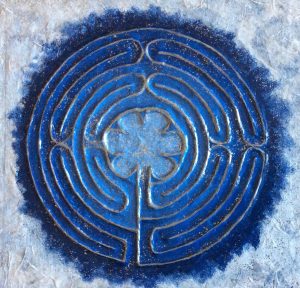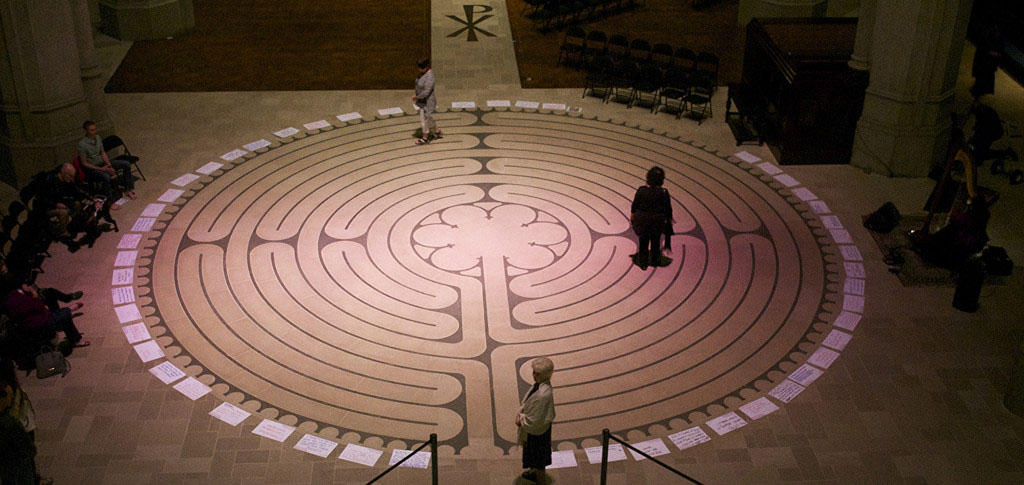History is full of circles, many understood but many more beyond understanding.
Often circles are more than simple shapes. Instead, they are experienced as sacred circles by indigenous communities. Sacred circles are based on an aboriginal approach to healing, as well as being a “traditional symbolic circle” that incorporates the spiritual beliefs of many Indian tribes of North America, including Cree, Dakota Nations, Blackfoot Confederacy, Saulteaux, Assiniboine nations and Canadian Plains indigenous tribes.
Because of their symmetry, circles were experienced in ancient Greece as representations of the divine and natural balance. Today, from the most well known circles, like The Lion King’s Circle of Life, to lesser known circles creating shape for labyrinths, many people have discovered the deeper meaning of the shape described as “eternity.”

Kathy Manis Findley
There is no doubt that nature relies on circles and circling, as described by Sharmon Davidson: “No one can say when the circle began to be thought of as a sacred symbol, but it’s not difficult to figure out why. Two circular objects inexplicably moved through the sky each day, and the sun was worshipped by many ancient peoples for the warm and light that it brought. The nighttime orb of the moon was often seen as its companion or counterpart, having opposing or complimentary energies and powers.”
On participation in circles
Whether we have taken note of it or not, all of us have participated in circles, even if just in a game of “gossip” or musical chairs. No doubt most of us have sat in circles at Sunday school, book clubs, class discussions and perhaps peacemaking circles. I have heard so often, “I feel like I’m going in circles!” I have said it, exasperated about my lot at a certain moment.
These days one can join all sorts of circles: peacemaking circles, restorative justice circles, women’s connection circles, domestic and sexual violence circles, youth and adult therapy circles, relaxation circles, democracy circles, healing circles and virtually every type of circle.
Peacemaking circles, for example, is how the Plains Indians settled disputes. A council would meet and discuss the nature of a problem, or crime, and every one would speak to the issue. Then elders would ponder the problem for a long time, finally reaching a solution. In this format, likely used by most tribal people, the elders always sat in a circle as a reminder that all were equal participants.
“When in the circle, no one is in front of you. No one is behind you.”
The wise words of Dave Yakima Chief offer us one of the most moving descriptions of the power of the circle: “The circle has healing power. In the circle, we are all equal. When in the circle, no one is in front of you. No one is behind you. No one is above you. No one is below you. The sacred circle is designed to create unity; … there is a place for every species, every race, every tree and every plant. It is this completeness of life that must be respected in order to bring about health on this planet.”
As I thought of the circle’s significance, I recalled a pilgrimage I made several years ago with Becca, my dear friend and colleague in ministry. At the time, the two of us were divided by state lines, but unified in a quest to follow a sacred path to a deeper spirituality. We decided on a pilgrimage to the two labyrinths, indoors and outdoors, at San Francisco’s Grace Cathedral, which is home to the Modern Labyrinth Movement.
Concentric circles as spiritual discipline
Labyrinths, which have appeared in many cultures since ancient times and in Christian spirituality since the fourth century, are used as a walking meditation, a spiritual practice, a way to quiet the mind, recover balance in life, encourage meditation, insight, self-reflection, and to promote stress reduction. A labyrinth is made up of concentric circles known as circuits. The practice of labyrinth walking integrates the body with the mind and the mind with the spirit.
 The labyrinth design, an ancient pattern found in many cultures, has been found on pottery, on Spanish petroglyphs or rock carvings, on tablets and tiles that date as far back as 5,000 years. Many patterns are based on spirals and circles mirrored in nature. In Native American tradition, the labyrinth is identical to the medicine wheel. The Celts described the labyrinth as the “never-ending circle.” It is also known as the Kabala in mystical Judaism.
The labyrinth design, an ancient pattern found in many cultures, has been found on pottery, on Spanish petroglyphs or rock carvings, on tablets and tiles that date as far back as 5,000 years. Many patterns are based on spirals and circles mirrored in nature. In Native American tradition, the labyrinth is identical to the medicine wheel. The Celts described the labyrinth as the “never-ending circle.” It is also known as the Kabala in mystical Judaism.
One feature labyrinths have in common is that they have one path that winds in a circuitous way to the center.
I have long been a student of Lauren Artress, canon pastor emeritus of Grace Cathedral in San Francisco. Seventy-five-year-old Artress, one of the world’s foremost authorities on labyrinths, has written four books on the subject, most recently, “The Path of the Holy Fool: How the Labyrinth Ignites our Visionary Powers.” In 1995, she founded Veriditas, a nonprofit foundation devoted to training labyrinth facilitators, as well as popularizing the labyrinth as a healing modality.
After her own pilgrimage to France, Artress transported her labyrinth vision to San Francisco’s Grace Cathedral. She was midwife to the dream of creating a labyrinth design that was a replica of the eleven-circuit Medieval Labyrinth from Chartres Cathedral in France. Although I had long been a student of Artress’s writings, as well as an avid student of the labyrinth, I never had walked one when Becca and I planned our pilgrimage.
Discovery and the sacred path
We arrived at Grace Cathedral and made our way to the labyrinth inside the cathedral. As we entered the huge wooden doors on Nob Hill, I was instantly caught up in the cathedral’s beauty. The sun through the stained glass windows reflected every color imaginable on the gleaming limestone and marble labyrinth. In fact, everything inside glistened in the sunlight. I hesitated for a moment to take it all in and then entered the sacred path.
Almost immediately, I realized the path was taking me through turns I didn’t see coming. No sooner than I determined I was moving one way and getting closer to what seemed like my destination, the sacred path turned, leading me the opposite way. I kept feeling I was getting closer to the center petals of the labyrinth, only to discover I was not.
“The labyrinth had taught me life would take me on a circuitous path with unpredictable twists and turns.”
After several times of walking what seemed like “the wrong way,” I surrendered to the idea that I had no idea how close I was to the destination (the labyrinth’s center). I did arrive there eventually, and I paused to take stock of what had happened. I realized this sacred path had shifted the metaphor of the spiritual life. I became fully aware that my life path was not a walk of perfection, with measured steps mandated by God as the sole guide through a “rule-bound life.” Instead, the labyrinth had taught me life would take me on a circuitous path with unpredictable twists and turns.
Transformation from walking the sacred path
From that transformative pilgrimage, the labyrinth has become part of my center with the power to help me with difficult paths through end-stage kidney disease, more than one brush with death, extensive physical and occupational therapy, five years of dialysis, a difficult kidney transplant and complex recovery. And all that was topped off with a pandemic and a suppressed immune system.
 Like the labyrinth path, this path of illness was not straight and orderly. Being so ill was a labyrinthine path of uncertainty. Still, I had practiced traveling exactly this kind of path by walking labyrinths.
Like the labyrinth path, this path of illness was not straight and orderly. Being so ill was a labyrinthine path of uncertainty. Still, I had practiced traveling exactly this kind of path by walking labyrinths.
I continued to contemplate labyrinths. I had several of them on my office walls. I taught classes about the labyrinth as a sacred path. I created several finger labyrinths. I walked the labyrinth closest to me. All this helped me on this hard journey. The labyrinth experience transcended my dismal reality and reminded me of the many and unique ways God and Spirit engage me on my sacred path. I have witnessed how the divine holds me close, abides with me on my journey, transforms my wounded soul and spirit, and shows me joy of life in the midst of uncertainty.
“The labyrinth experience transcended my dismal reality and reminded me of the many and unique ways God and Spirit engage me on my sacred path.”
Those who follow their own sacred path may well need this spiritual discipline. Congregations, confused and in transition after the pandemic, may need such a spiritual discipline. Spirituality can seem ethereal or otherworldly at times, feeling almost out of human reach, but the labyrinth is something tangible. I have seen the labyrinth walk captivate persons who need to compulsively move. While meditation and prayer is too still for them, they learn to pray and meditate as they follow the path.
In walking the labyrinth, we travel across a bridge that enlivens our human imagination and connects us with the divine imagination. Our imagination then becomes a life-giving source with effervescence, mystery and the meaning of being human woven into our labyrinth walk.
Perhaps it’s just what we need. Perhaps we should search for a finger labyrinth online or find a nearby labyrinth to walk by visiting the worldwide labyrinth locator. Receive what is there for you to receive. It could well be transformative.
Kathy Manis Findley is an ordained Baptist minister with Greek Orthodox roots. Now retired in Macon, Ga., she spent her 38-year ministry serving as a pastor, hospital chaplain, trauma counselor and missionary to Uganda. She is a graduate of Southern Baptist Theological Seminary and is certified in victimology, trauma intervention and child forensic interviewing. She is the author of two serious books, Voices of our Sisters and The Survivor’s Voice: Healing the Invisible Wounds of Violence and Abuse, and just for fun, one Kindle novel.
Related articles:
Discovering your community through the practice of the Labyrinth | Opinion by Rachel Gillespie
Labyrinth transforms prayer life, Baptists say
Learning from Alma Woodsey Thomas how to find beauty within, around and through life | Opinion by Phawnda Moore


